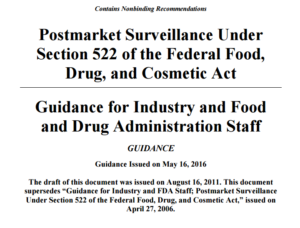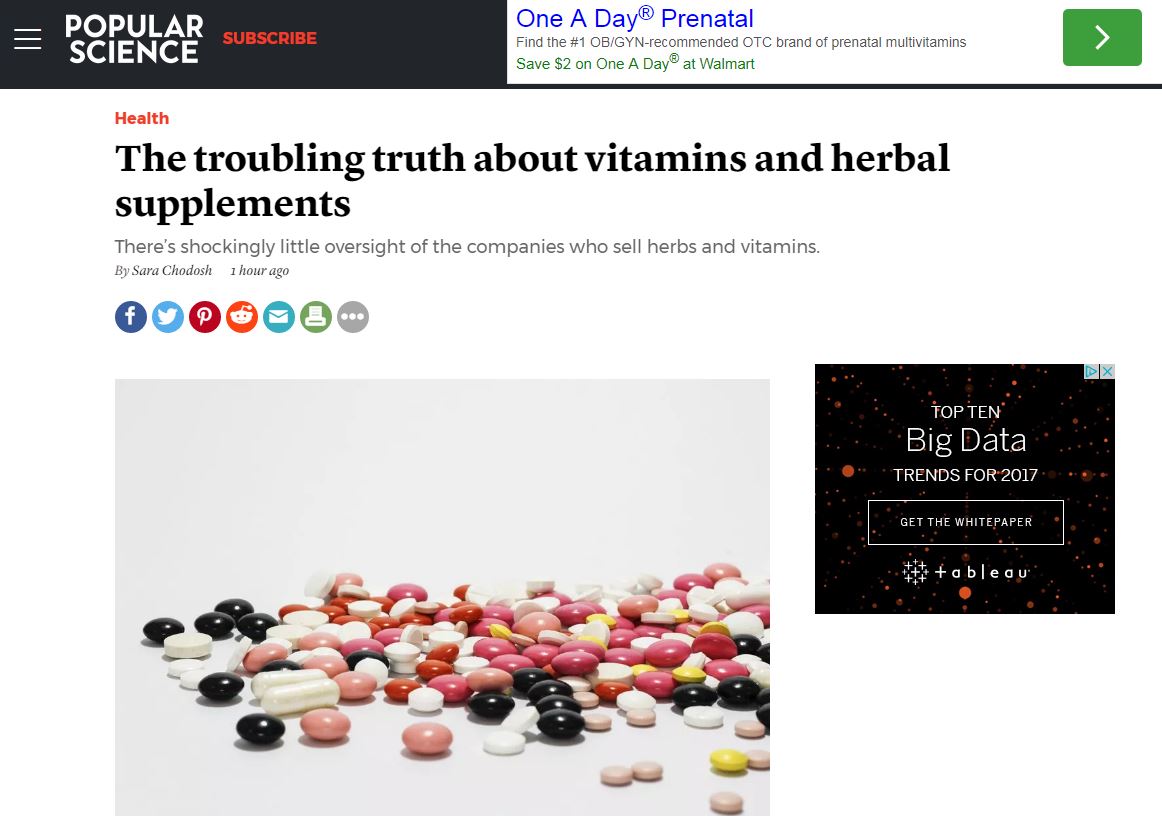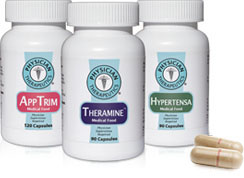Blog
POPULAR SCIENCE; BAD JOURNALISM
This is a duplicate post to one on my main blog: https://compliancearchitects.com/blog/
Two months ago I posted in LinkedIn about a Popular Science article that unfairly characterized FDA’s regulatory process, and implied FDA tacitly agreed with a company’s characterization of what can best be considered a sham product as a medical device. See, https://www.linkedin.com/feed/update/urn:li:activity:6277978180909305856
Now, Popular Science has, in an article today, misrepresented the science, safety and adverse event experience of the dietary supplement industry, and confused dietary supplements with homeopathic remedies, creating confusion and doubt for their readers, while mis-characterizing the actual problem: homeopathic drugs.
According to the Federal Food Drug and Cosmetic Act, any article recognized in the Homoeopathic Pharmacopoeia of the United States is expressly recognized as a drug. See 21 USC 321(g)(1)(A). By contrast, dietary supplements are designated as a separate class of legal products, with completely different defining characteristics in the law. See 21 USC 321(ff). While the marketing and distribution of both homeopathic drugs and dietary supplements are legal in the US pursuant to the FFDCA, they are separately regulated products, with differences in allowable claims, manufacturing requirements, and other regulatory expectations. Note: FTC also has jurisdiction over both product classes for marketing/advertising substantiation requirements.
Since the formal establishment of the term “dietary supplement” within the FFDCA pursuant to the Dietary Supplement Health and Education Act of 1994, FDA and the dietary supplement industry have jointly participated in a transition from a loosely-defined set of FDA expectations, to a risk-appropriate set of regulatory requirements that seems to be working reasonably well for a set of products that the public wants, and that pose little apparent risk to the consuming public.
Homeopathic drugs on the other hand are much different. First, it appears from a review of the OTC aisles in a local pharmacy that there are many products that are masquerading as homeopathic drugs when in fact, they may be dietary supplements or just products using the homeopathic “allowance” to get to market without a pre-market authorization. This is problematic, since as a drug, under the law, a company may make claims that the product can “prevent, treat, cure or mitigate” a disease state – whatever that may be. The effect of which is that these homeopathic “drugs” are making disease-state claims – often without any underlying shred of scientific evidence that they work.
So let’s get back to Popular Science. The author of the article has completely confused dietary supplements with homeopathic remedies. She cites the lack of pre-market approval requirements for dietary supplements as proof that “that a huge fraction of botanical supplements either contain an entirely different active ingredient from what they claim or contain a filler like rice powder.” Anyone who understands the industry knows that a pre-market approval requirement has NO relation to the requirement for a dietary supplement (or pharmaceutical) to contain what it label claims it does – otherwise it is adulterated under the FFDCA. She asserts that “from 2005 to 2012, the rate of reported dietary supplement exposures increased 49.3 percent.” She then, recognizing some difference, asserts that “[h]omeopathic cures and ma huang-containing pills were responsible for most of that….” Her confusion of the regulated product classes, and inability to separate pre-approval issues, manufacturing issues, and post-market surveillance issues creates confusion for the reader by intimating that homeopathic cures are dietary supplements, and that dietary supplement products are unregulated, dangerous, and not subject to oversight by the FDA.
While there is a great deal that could be written on this topic, the main thrust is this: Popular Science is not adhering to even basic editorial standards relative to articles concerning FDA regulation. They are wrong about FDA regulation, wrong about causal factors, and are doing a disservice to their readers. I have loved reading Popular Science over the years, but if this is the level of journalistic and editorial rigor applied to their articles, what else am I reading there that is inaccurate / just plain wrong.
Be careful with homeopathic remedies. Be careful with Popular Science.
FDA Issues FFDCA § 522 Guidance … Finally
 After five long years, FDA has finally issued the final guidance for medical postmarket surveillance requirements under section 522 of the Federal Food Drug and Cosmetic Act. The new guidance, issued today, 16 May 2016, shows a level of regulatory discipline not seen in some recent guidances, and outlines the statutory framework and basis for postmarket surveillance activities, and what manufacturer obligations are with respect to such activities. The Guidance expands upon the Draft Guidance issued in August, 2011 and follows the same basic structure and elements (although much expanded). This Guidance is an essential element of FDA’s public health protection mandate, to ensure that specific types and implementations of devices have an appropriate framework in place to identify and report on field medical device issues and problems.
After five long years, FDA has finally issued the final guidance for medical postmarket surveillance requirements under section 522 of the Federal Food Drug and Cosmetic Act. The new guidance, issued today, 16 May 2016, shows a level of regulatory discipline not seen in some recent guidances, and outlines the statutory framework and basis for postmarket surveillance activities, and what manufacturer obligations are with respect to such activities. The Guidance expands upon the Draft Guidance issued in August, 2011 and follows the same basic structure and elements (although much expanded). This Guidance is an essential element of FDA’s public health protection mandate, to ensure that specific types and implementations of devices have an appropriate framework in place to identify and report on field medical device issues and problems.
The authority for the requirement for postmarket surveillance goes back two decades, although guidance on the who, how, and when has been lacking complete definition, until now. The new Guidance provides the internal FDA process for the issuance of a Section 522 “order” outlining a requirement on behalf of a manufacturer to conduct device-specific postmarket surveillance activities, and, the process whereby manufacturers must submit their postmarket surveillance “plan”, within 30 days of the postmarket surveillance order.
The Guidance outlines the basic elements of the postmarket surveillance submission, including (see guidance for all elements):
- patient population (including subject inclusion and exclusion criteria and definition and source of comparator group)
- sample size calculation (statistically justified and based on study hypothesis, where applicable)
- primary and secondary endpoints (including definitions for endpoints, success criteria, a list of expected adverse events/complications, an agreement to collect unexpected adverse events, and a plan to assess relatedness of endpoints with the device and/or the procedure)
- length of follow-up, follow-up schedule, description of baseline, and follow-up assessments, where applicable
- description of data collection procedures (including recruitment plans, enrollment targets, plans to minimize losses to follow-up, follow-up rate targets, quality assurance, and control), where applicable, and
- statistical analysis
FDA will review, assess and approve or disapprove the plan. Given FDA’s clear statutory authority and length of time industry has had the Draft Guidance, it will be incumbent on manufacturers to be well prepared to develop robust plans with broad applicability, as failure to comply with the order and submit a plan to FDA’s approval is a prohibited act under the FFDCA, resulting in affected devices being misbranded under the Act.
All manufacturers should be sure they are familiar with the Final Guidance, and hopefully, they are already well down the path towards full compliance, given the five years of the Draft Guidance being in place. The final Guidance can be found here: Final Section 522 Order Guidance
FDA Issues New Medical Foods Guidance
FDA has finally published a guidance on the use and classification of “Medical Foods”. As has been the recent trend of FDA, the guidance is formatted as a Frequently Asked Questions (FAQ) document, as opposed to a guidance for how to determine, implement, execute, etc. In this case, however, the format may be appropriate, as many of the questions surrounding medical foods surround what IS a medical food, and what are the limits on the ability to use the statutory classification.
The guidance deals with the following topics:
- What is a medical food?
- Has FDA established by regulation any criteria that clarify the statutory definition of a medical food?
- Does FDA regulate medical foods as drugs?
- Do the labeling requirements for nutrient content claims apply to medical foods?
- Do the labeling requirements for health claims apply to medical foods?
- What labeling requirements apply to medical foods?
- What other FDA requirements apply to medical foods?
- Does the Food Allergen Labeling and Consumer Protection Act of 2004 (FALCPA) apply to medical foods?
- Where can I find more information on FALCPA’s labeling requirements?
- What are the registration requirements for medical food facilities?
- Does FDA maintain a list of medical foods?
- Is there a compliance program guidance manual for medical foods?
- What is the purpose of FDA’s compliance program for medical foods?
- Does FDA require that medical foods be made available by written or oral prescription?
- How does FDA interpret “under the supervision of a physician”?
- May the labeling of a medical food bear the symbol “Rx only”?
- Should National Drug Code (NDC) numbers be used in the labeling of medical foods?
- What requirements apply to ingredients added to medical foods?
- Where can I find additional information on food additives and GRAS ingredients?
- Does FDA generally consider inborn errors of metabolism (IEMs) to be diseases or conditions that a medical food could be used to manage?
- Are there any examples of specific IEMs that medical foods could be used to manage?
- Does FDA consider pregnancy to be a disease?
- Are there distinctive nutritional requirements associated with pregnancy?
- Does FDA consider pregnancy to be a condition for which a medical food could be labeled and marketed?
- Are there distinctive nutritional requirements associated with the management of diabetes mellitus (DM)?
- Does FDA consider DM to be a condition for which a medical food could be labeled and marketed?
- Does FDA consider diseases resulting from essential nutrient deficiencies (e.g., scurvy, pellagra) to be diseases for which a medical food could be labeled and marketed?
- Does FDA consider conventional foods that, in their natural state, do not contain protein or are low in protein to meet the definition of a medical food?
The guidance can be found here: FDA Guidance on Medical Foods


